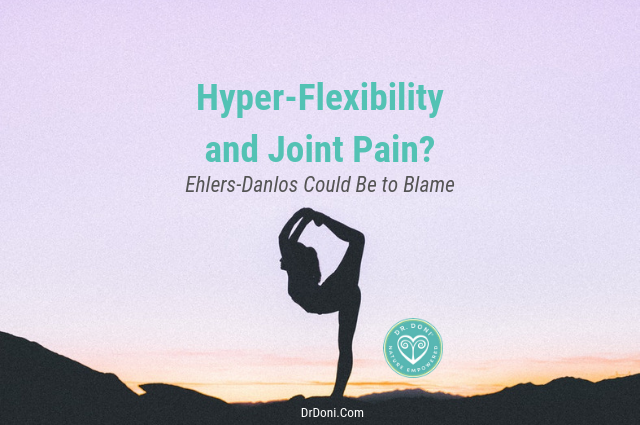
Hyper-Flexibility and Joint Pain? Ehlers-Danlos Could Be to Blame
- Home
- Genetic Mutations
- Hyper-Flexibility and Joint Pain? Ehlers-Danlos Could Be to Blame

Find yourself to be more flexible than others or have you become accustomed to dislocations and joint pain? Ehlers-Danlos Syndrome may be the cause.

Sitting in the car on the way to work…
Carrying a single grocery bag from the car…
Walking to the park with your kids…
Any and all of these seemingly everyday activities can cause tremendous pain for those suffering from Ehlers-Danlos Syndrome (EDS).
Even worse? Many go undiagnosed—and in pain—for years. I should know because I was one of them.
What is Ehlers-Danlos Syndrome?
It would probably help to start with exactly what EDS is… except that even the medical community is still trying to nail it down. What was once thought to be a pretty rare genetic condition is now being defined as a group of related conditions, including hypermobile spectrum disorders (HSD); all with one thing in common, however: collagen.
Speaking broadly, EDS is an increasingly more recognized collagen condition that potentially affects the joints, skin, heart, and in rare cases, the blood vessels. The way it presents varies in each person, which can make it easier to miss—and is why people with EDS often refer to themselves as “zebras” (indicating a rare medical condition).
Collagen—the typically tough, fibrous structural component throughout the human body—is essential for strengthening connective tissue, holding our joints in place, and at the same time, allowing for movement.
But that’s not exactly the case for those with EDS…
Stretchy collagen lends to flexibility, but also to joints that easily dislocate.
Symptoms of EDS
Speaking from my own experience, I never considered the same hyper-flexibility that made me a great gymnast also the culprit for my intrusive and intense migraines. It wasn’t until I began to see more and more patients that presented classic EDS symptoms that I realized I also met the criteria.
In regards to collagen, those with EDS often have collagen that is more stretchy, which can affect various areas of the body, resulting in different symptoms for each person, depending on what areas of the body are affected.
In a nutshell, the symptoms could present as:
- Hyper-flexibility/ Hyper-mobility: Easily dislocated joints such as elbows, knees, shoulders, ribs, fingers, and toes.
- Stretchy or loose skin. Prominent scars or stretch marks.
- Headaches and muscle tension.
- Chronic musculoskeletal pain. Often referred to as fibromyalgia.
- Digestive issues, such as hiatal hernia and reflux/heartburn.
- Allergies and mast cell activation syndrome
- Fatigue
- Prone to frequent injuries or “clumsiness.”
- Fragile blood vessels that cause frequent bruising, varicose veins, or in VERY rare cases, aneurysms.
While it can be difficult to keep up with the ever-changing definitions and criteria of EDS, it is important to be aware of how wide the spectrum is. To learn more about the (currently) 13 subdivisions of EDS, click here.
Addressing Ehlers-Danlos
I had always assumed that my body simply needed more bodywork, massages and physical therapy than others. Once I realized that I too suffer from EDS, it actually made treating my pain easier. The biggest difference maker for me was knowing that everyday habits could improve my quality of life. In fact, it turns out that most everything I had found helpful for my health over the years, is also helpful for EDS.
For example, the introduction of a committed pilates routine almost immediately proved to be effective. It allowed me to become aware of my joint positions and to increase my strength in my core (abdominal muscles) and joints that often dislocate, such as my hips, neck, and shoulders. This was even before I knew I had EDS.
I learned first that when joints are highly mobile, it helps to have strong muscles to hold them in place. I also learned that posture is EVERYTHING.
I kicked it up a notch and started my journey to beating the daily pain and frequent joint injuries. As soon as I started using a standing desk, my pain decreased and my life changed. I got a new mattress for my bed—without flame retardant— and worked to optimize my sleep (see my sleep checklist and bestselling Natural Insomnia Solutions book here.)
I stayed focused on optimizing adrenal function (as I have for 20 years), continued to avoid gluten and my other food allergens (which increases inflammation and pain), and essentially made a healthy lifestyle my top priority. While choosing self-care is not always easy when there are many competing interests and a long to-do list, when you have EDS, it is a must. Otherwise, I would spend my “time off” in bed recovering.
I found a physical therapist who specializes in hypermobility. She is a game changer. She can identify a rib out of place and have it back in line before you know it. I finally began to understand why the slightest stresses sent me into a whirlwind of pain… and more importantly, how to get out of it.
Still, one thing I didn’t try immediately (even though I read about it for years and now wish I had) was Helminth Therapy.
Introducing Helminth Therapy to my life has been invaluable in more ways than one. Aside from alleviating debilitating allergies, intolerances, and headaches, it has directly improved my EDS symptoms by making it possible for me to go to the gym and lift weights without ending up in pain. Previously, I had to stick to low weights and low reps. Now, I go to the gym at least five days a week and am able to increase my strength without setbacks. So now I put helminth therapy at the top of the list of recommendations.
To Recap, Steps to Help with Ehlers-Danlos and Hypermobility:
- Find out how stress has affected your cortisol and adrenaline levels. Most practitioners don’t offer this type of testing, so you’ll want to work with a practitioner who does.
- Find out your food sensitivities with a home food sensitivity panel so you know which foods are increasing inflammation and pain, so that you can avoid them, and to get a sense of the degree of leaky gut that needs to be addressed.
- Support your body to recover from stresses of all types by working with a practitioner who can help you to use nutrients and herbs to get your cortisol and adrenaline levels back optimal. Grab my FREE Guide to Adrenal Recovery HERE.
- Heal leaky gut and get your gut bacteria back on track. The Stress Remedy Program is a great way to begin making diet changes and healing leaky gut.
- Find practitioners how understand EDS and hyper-mobility who can help you with physical therapy, balance, posture, and strength, such as with Pilates.
- Use naturally-derived supplements to support joint health, such as collagen and Khavinson peptides.
- Use medication-free methods to decrease pain and inflammation, including bromelain, curcumin, cannabinoids, helminth therapy
Your Path to Feeling Great
Keep in mind that you likely won’t hear these suggestions from your standard medical practitioner. In addition to the fact that EDS is often missed or given another name (fibromyalgia, for example), there simply are not known effective treatments. Many people live their lives in pain and on pain medications.
I feel strongly that that does NOT need to be the story for those of us with EDS. There are solutions that have helped me, and I’d love for you to benefit too. I feel great, am not in pain anymore, and know how to keep it that way.
The main takeaway should be this: healthy collagen helps to keep joints in place to prevent dislocation and pain. Strengthening your muscles, decreasing inflammation and recovering from stress all help to prevent injuries and daily discomfort.
Don’t live day to day with painful joint or muscle pain from common activities meant to be enjoyed. If you suspect you’re suffering from EDS, let’s connect to discuss how I can help.
Most patients I help with EDS start with my Adrenal Recovery Program, which you can read about here.
Start to focus on your adrenal recovery now—using with my self CARE method. This approach made a world of difference before I even knew I had EDS but then saw the associated benefits. Sign up for my 7-day Stress Reset to help you implement self CARE for free here.
For more on recovering from stress, read the Stress Warrior book for free online here.
Share this Post:
Dr. Doni Wilson's Team
14 Day Detox Program
Take the Stress Type Quiz
Dr. Doni Social Media
Popular Posts


The 5 Burnout Types

Healing HPV Holistically: Dr. Doni on the Inspire Health by Jen Podcast

Recent Podcasts
Signup to receive our weekly newsletter with all the latest news, podcasts and special offers
New Book - Order Today!

SIMPLE PRACTICES for SHIFTING FROM YOUR STATE of STRESS to YOUR FLOW and FREEDOM
MASTER YOUR STRESS
RESET YOUR HEALTH
Order Now! Related Posts

What is making you susceptible to HPV?
I have been working with women who had abnormal cells on their cervix and/or vaginally, caused by HPV for over 20 years now. And while

The 5 Burnout Types
Did you know there are 5 burnout types? They are based on your Stress Type®, which is how your adrenal function has been affected by

Healing HPV Holistically: Dr. Doni on the Inspire Health by Jen Podcast
Dr. Doni was interviewed by Jen Ciszewski on the Inspire Health by Jen Podcast, talking about how to heal away HPV from your body for good.

Stress and Trauma: The Science Behind It, How It Shows Up and How to Heal: Dr. Doni on The Burn Fat and FEAST Podcast
Dr. Doni was interviewed by Sarah B. Thomas on the Burn Fat and FEAST Podcast, talking about the impact of stress and trauma on our health and what to do to recover from them.














